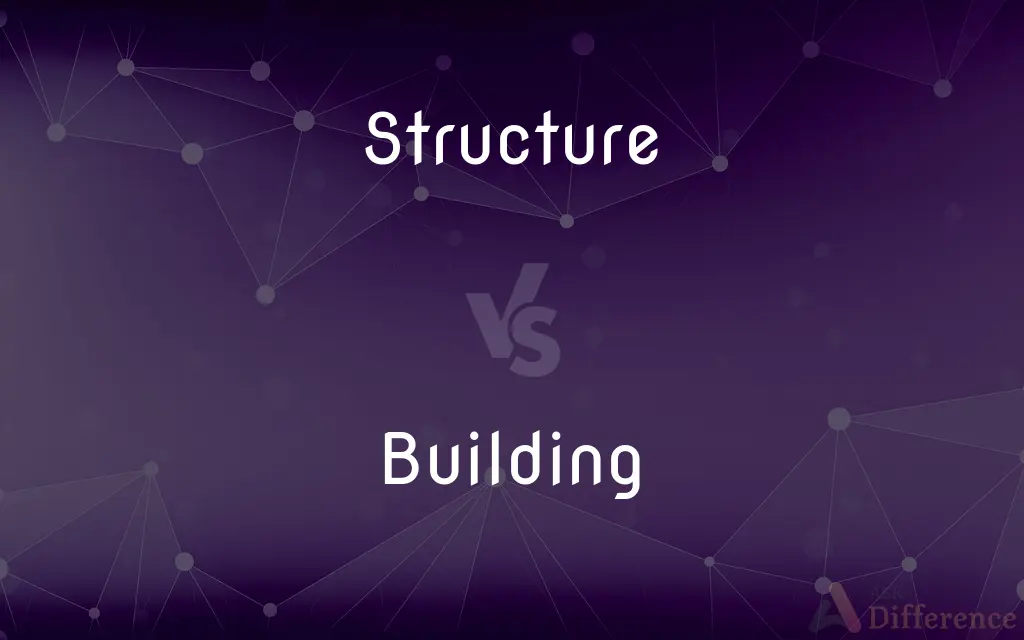Structure vs. Building — What's the Difference?
By Tayyaba Rehman & Urooj Arif — Updated on March 2, 2024
A structure is any constructed assembly that provides support or enclosure, including bridges, towers, and buildings, while a building is a type of structure specifically designed for occupancy, whether it's for residential, commercial, or public use.

Difference Between Structure and Building
Table of Contents
ADVERTISEMENT
Key Differences
A structure encompasses a wide range of human-made constructions that provide support, stability, or enclosure. This broad category includes not only buildings but also bridges, towers, dams, tunnels, and even temporary setups like scaffolding. Structures are defined by their purpose of standing against loads and forces such as gravity, weather, and human use. They are fundamental to various fields, including civil engineering, where the focus is on their design, construction, and integrity to ensure safety and functionality.
Buildings, on the other hand, are a subset of structures specifically designed for human occupancy and use. They are enclosed spaces with walls and roofs, created for purposes ranging from living, working, and storage, to worship and recreation. Buildings are characterized by their permanence and are often designed with considerations for aesthetics, energy efficiency, and environmental impact, in addition to structural integrity. Examples include houses, office buildings, schools, and churches.
While all buildings are structures, not all structures are buildings. The key distinction lies in the intended use: structures serve a broader array of purposes including support and connectivity (like bridges and tunnels), whereas buildings are primarily focused on creating habitable and usable spaces for people. This differentiation is crucial in fields such as architecture and civil engineering, where the design and construction considerations vary significantly based on the intended use, safety requirements, and regulatory standards.
The engineering behind structures is focused on their ability to withstand various forces and provide necessary support, while buildings additionally incorporate elements of design and functionality that cater to human occupancy. Environmental conditions, material properties, and legal standards play significant roles in the planning and development of both, but buildings have the added complexity of interior environmental control, accessibility, and often, a higher level of aesthetic design.
The concept of structure is about the fundamental aspects of support and stability, applicable to a wide range of human-made constructions. Building design, however, delves into the specifics of creating spaces for people to live, work, and engage in activities, requiring a more detailed approach to aspects like comfort, usability, and compliance with building codes and standards.
ADVERTISEMENT
Comparison Chart
Definition
Any constructed assembly that provides support or enclosure.
A type of structure designed for occupancy and use.
Includes
Bridges, towers, dams, tunnels, buildings.
Houses, offices, schools, churches.
Purpose
To stand against loads and forces.
To provide habitable and usable spaces for humans.
Focus
Support, stability, and enclosure.
Occupancy, functionality, and aesthetics.
Fields Involved
Civil engineering, construction.
Architecture, civil engineering, urban planning.
Compare with Definitions
Structure
Designed for durability and stability.
Dams are structures built to control water flow and generate electricity.
Building
Subject to building codes and regulations.
Office buildings must comply with safety and accessibility standards.
Structure
Focuses on the physical integrity and safety.
Tunnels are structures that require careful engineering to ensure they are safe for transportation.
Building
A building is a permanent structure with walls and a roof for occupancy.
The Empire State Building is a landmark office building in New York City.
Structure
A structure is any engineered construction designed to bear loads.
The Eiffel Tower is a structure known for its iconic design and engineering.
Building
Incorporates considerations for human comfort and safety.
Residential buildings are designed with living spaces that provide comfort and privacy.
Structure
Can be temporary or permanent.
Scaffolding is a temporary structure used during the construction or repair of buildings and bridges.
Building
Often reflects architectural styles and cultural significance.
Churches are buildings that often feature distinctive architectural designs reflecting cultural and religious importance.
Structure
Structures encompass a wide range of constructions.
The Golden Gate Bridge is a structure that provides connectivity and support.
Building
A structure with a roof and walls, such as a house or factory.
Structure
A structure is an arrangement and organization of interrelated elements in a material object or system, or the object or system so organized. Material structures include man-made objects such as buildings and machines and natural objects such as biological organisms, minerals and chemicals.
Building
Designed for various uses including residential, commercial, and public.
Schools are buildings dedicated to education and learning.
Structure
The arrangement of and relations between the parts or elements of something complex
The two sentences have equivalent structures
The company's weakness is the inflexibility of its management structure
Building
A building, or edifice, is a structure with a roof and walls standing more or less permanently in one place, such as a house or factory. Buildings come in a variety of sizes, shapes, and functions, and have been adapted throughout history for a wide number of factors, from building materials available, to weather conditions, land prices, ground conditions, specific uses, and aesthetic reasons.
Structure
A building or other object constructed from several parts
The station is a magnificent structure and should not be demolished
Building
The action or trade of constructing something
The building of motorways
Building materials
Structure
Construct or arrange according to a plan; give a pattern or organization to
Services must be structured so as to avoid pitfalls
Building
The act of constructing or building something;
During the construction we had to take a detour
His hobby was the building of boats
Structure
Manner of organization; the arrangement of the different tissues or parts of animal and vegetable organisms; as, organic structure, or the structure of animals and plants; cellular structure.
Building
The occupants of a building;
The entire building complained about the noise
Structure
The manner of construction of something and the arrangement of its parts;
Artists must study the structure of the human body
The structure of the benzene molecule
Structure
The people in a society considered as a system organized by a characteristic pattern of relationships;
The social organization of England and America is very different
Sociologists have studied the changing structure of the family
Common Curiosities
How do the design considerations for buildings differ from other structures?
Design for buildings often incorporates additional elements like interior environmental control, aesthetics, and compliance with specific occupancy standards, beyond the structural integrity focused on in other structures.
Can a building be a structure?
Yes, all buildings are considered structures, but not all structures are buildings.
Why are buildings subject to specific codes and regulations?
Buildings are subject to codes and regulations to ensure they are safe, accessible, and environmentally responsible for human occupancy and use.
What are some examples of structures that are not buildings?
Bridges, dams, tunnels, and scaffolding are examples of structures that are not buildings.
What makes a structure different from a building?
Structures encompass a broad range of constructed items for support or enclosure, while buildings are specifically designed for human occupancy and use.
Can the function of a building change over time?
Yes, the function of a building can change, requiring renovations or adaptations to meet new occupancy needs or standards.
What is the importance of load-bearing in the design of structures?
Load-bearing is fundamental to the design of structures to ensure they can withstand forces like gravity, weather, and human use without collapsing.
What role does architecture play in the construction of buildings?
Architecture plays a crucial role in the design of buildings, focusing on aesthetics, functionality, and the creation of spaces that meet human needs and reflect cultural values.
How do environmental conditions affect the design of structures and buildings?
Environmental conditions significantly influence design choices, materials selection, and construction techniques to ensure the longevity and safety of structures and buildings.
How do temporary structures differ in design from permanent buildings?
Temporary structures, like scaffolding, are designed for short-term use with a focus on ease of assembly and disassembly, whereas permanent buildings are designed for long-term durability and functionality.
Share Your Discovery

Previous Comparison
Biomining vs. Bioleaching
Next Comparison
Blank vs. DummyAuthor Spotlight
Written by
Tayyaba RehmanTayyaba Rehman is a distinguished writer, currently serving as a primary contributor to askdifference.com. As a researcher in semantics and etymology, Tayyaba's passion for the complexity of languages and their distinctions has found a perfect home on the platform. Tayyaba delves into the intricacies of language, distinguishing between commonly confused words and phrases, thereby providing clarity for readers worldwide.
Co-written by
Urooj ArifUrooj is a skilled content writer at Ask Difference, known for her exceptional ability to simplify complex topics into engaging and informative content. With a passion for research and a flair for clear, concise writing, she consistently delivers articles that resonate with our diverse audience.













































